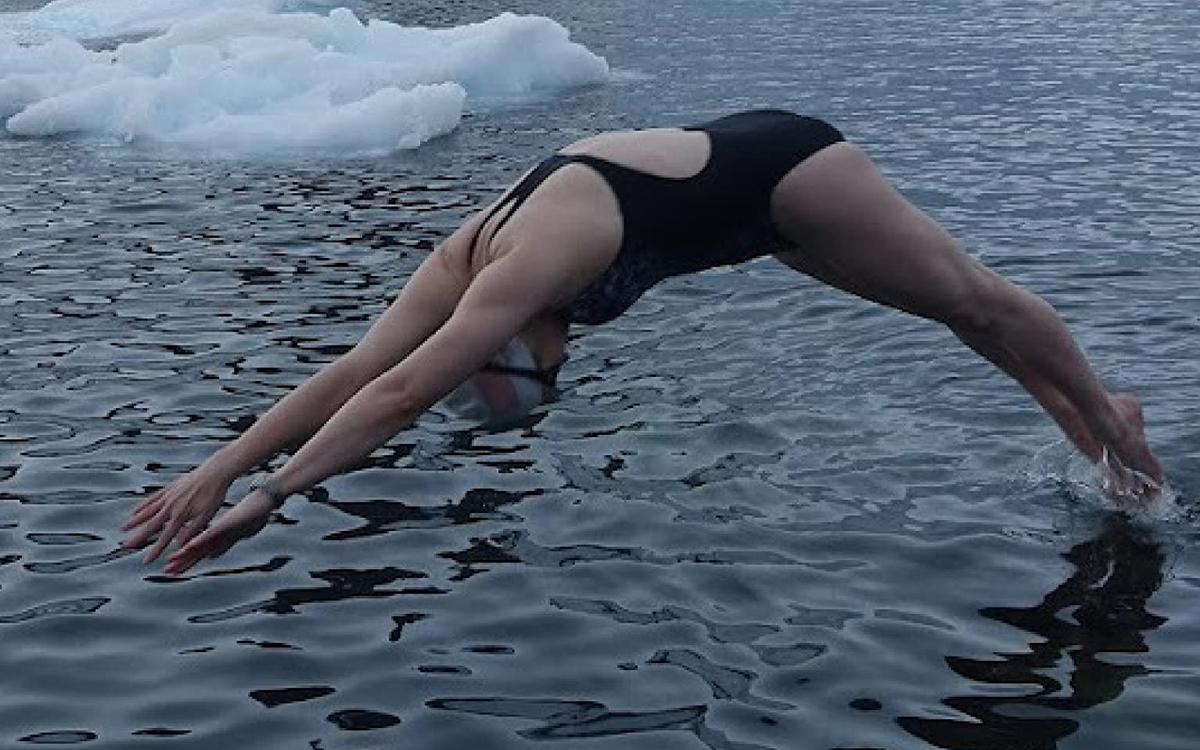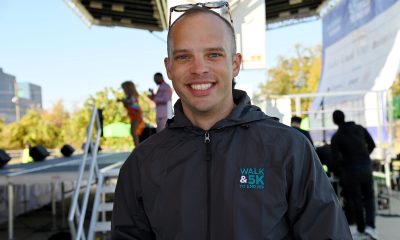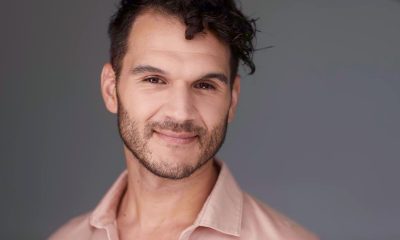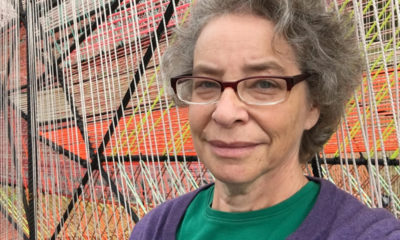Books
Nonbinary poet unmasks society’s gender expectations in new collection
Karen Poppy’s ‘Diving At The Lip Of The Water’ debuts next week

“I started to compose poetry around the age of three – before I could even write,” poet Karen Poppy, 47, told the Blade in a telephone interview. “My Mom would write my poems down.”
“I had the good fortune,” added Poppy, whose first, full-length poetry collection “Diving At The Lip Of The Water” will be out from Beltway Editions, a Washington, D.C. area press, on May 1, “My Mom read poetry to me. The first poem was about a nightingale. Maybe she read Keats to me.” (John Keats was the 19th century Romantic poet who wrote “Ode to a Nightingale.”)

Poppy has written a book “that will rough a reader up and then wrap their scraps in silk,” poet Francesca Bell has said of “Diving At The Lip of The Water.” For Poppy, who identifies as queer, nonbinary, lesbian and an artist, coming out has been a lifelong process. “I’ve come out many times in many ways,” Poppy, who grew up in Foster City, Calif., and now lives in the San Francisco Bay area, said.
April is National Poetry Month. In every month, Poppy thinks often of Walt Whitman, one of the United States’ greatest poets. Thought by many to be queer, Whitman, a nurse in Washington, D.C. during the Civil War, is best known for his groundbreaking work “Leaves of Grass.”
Whitman comes to mind to Poppy when she talks about her identity. “As an artist,” Poppy said in reference to how she identifies, “I’m everyone and everything.”
When Whitman talks about the self containing “multitudes,” “He’s not just speaking of individuals,” Poppy said, “he’s saying that poets-artists enter into everything.”
“As an artist – a poet,” Poppy said, “I don’t like to be put into boxes.”
Poppy celebrates Whitman’s creative spirit, refusal to have limitations placed on him and, what she called, “his joyous experience of limitlessness and connectivity with everything.”
As a young child, Poppy sensed that she was different. “I knew very early on,” she said, “I wanted to be like my mother and my father.”
She wanted to be glam like her mom. “My Mom’s family’s nickname for Mom was Miss America,” Poppy said.
She wore her Dad’s leather jacket, cowboy hat and cowboy boots. “Early on, I got in trouble for trying to smoke a cigarette,” Poppy said, “I put it in the wrong way. I was lucky I didn’t burn my mouth!”
“I cut my mouth, trying to shave as a toddler,” she added, “I was already creating my own gender identity.”
At a time, when people were far less out and proud than now, Poppy crushed on her girl babysitters. “In kindergarten, I got in trouble with my best friend at the time,” she said, “because I told her that I was interested in her physically.”
“I think she was very kind about it,” Poppy added.
That same year, Poppy was reprimanded by her teacher for kissing a boy. “The boy and I were in line waiting to go back to the classroom,” she said, “he kissed me back.”
During that era, Poppy didn’t have the words to name or describe her feelings. “I have a gay cousin who’s older than me,” she said, “and a lesbian aunt. But because they weren’t exactly the way I am, I didn’t realize I was queer, too.”
In Foster City, when she was growing up, people didn’t talk openly about being queer. “We talked about it in euphemisms and negatively,” Poppy said.
A poem is never just the story of what happened or the recitation of fact, poet Sheila Black, a 2012 Witter Bynner Fellow, said in an email to the Blade.
Poppy’s poetry, like that of many poets, at times, channels her life. Though, it’s not autobiographical in a literal or linear way. Like Whitman’s work, it contains multitudes from individual and collective experience.
Her searing, moving collection “Diving At The Lip Of The Water,” unmasks society’s gender expectations and family systems. Poppy’s poem, “No One was Gay Back Then,” draws us into what it’s like to have to hide your sexuality. “We used to make fun of you/You, making out with Michael/in the grass. 5th grade recess,” the poem begins.
“Michael liked Matt. So in 5th grade,” Poppy writes in the poem, “already seeking cover-ups/Trying to convince everyone and ourselves./Our small town. No one was gay back then.”
As a tween, Poppy not only realized she was queer (though she didn’t have the word for it); she knew where she wanted to go to college. Poppy was determined to go to Smith College because Sylvia Plath went there.
“When I was 12, I started to read Sylvia Plath,” Poppy said. “Plath has been a profound influence on me throughout my life.”
“Because of her fearlessness in speaking her truth,” Poppy added, “and her high level of poetic virtuosity.”
Poppy’s dream came true. She earned a bachelor’s degree from Smith College in Comparative Literature and Spanish in 1998.
At Smith, Poppy began to come out about her identity. But, there were pressures. “I was pressured into cutting my hair short,” she said, “the feeling was if I kept my hair long, I wasn’t a dyke.”
Poppy cut her hair. “I did cry,” she said, “there was a pressure to conform to a certain aesthetic. You had to be super femme or butch.”
It was another box that she had a hard time escaping from. “I realized boxes are not for me,” Poppy said.
She wasn’t sure what she wanted to do after she graduated from Smith. After a short stint as a chef apprentice, Poppy could tell that being a chef for the long term wasn’t for her.
Like most poets, Poppy knew being a bard rarely brings financial stability. “I wanted to have security and I wanted to help people,” Poppy said.
“I went to law school and studied international law,” she said, “A lot of my early focus was on immigration and helping refugees.”
Poppy graduated from UC Hastings College of the Law (now known as UC College of the Law, San Francisco) in 2003 with a J.D. degree in international law.
Today, Poppy works for The Hartford in the area of workers’ compensation.
Poppy kept writing from her childhood into her 20s. “But then, somebody said something really cruel about my writing,” she said. “The ridicule chilled my creativity.”
For 17 years, because of this cruelty, she didn’t write. “I was in a creative silence,” Poppy said.
A traumatic event compelled her to go back to writing.
Since 2017, when her creativity was restarted, Poppy’s poetry has been published in literary journals, anthologies as well as the chapbooks “Crack Open/Emergency,” “Our Own Beautiful Brutality” and “Every Possible Thing.” She’s written three unpublished novels and short stories.
One of her writing projects is Whitmanesque in its intersections of identities.
Poppy is working on an opera libretto. “It takes place when Handel [the German-British Baroque composer] was alive,” she said.
It’s about a merboy who’s washed to shore. He’s young, Black and queer.
“A family takes him in,” Poppy said, “they want to make him a form of income.”
The family forces the merboy to become a castrato, Poppy said, “they make him wear a mask to hide his dark skin. When he’s older and has a relationship with a man, he has to be closeted.”
Poppy is looking for a composer to work with her on her libretto. If you’re interested, contact her through her website karenpoppy.com.
Poppy’s interest in immigrants is personal as well as professional. Poppy is Jewish. Some of her family were murdered in the Holocaust. “Others in my family left Europe before the Holocaust because of pogroms and poverty,” she said.
When her family came to the United States in the early 1900s, they were “very poor,” Poppy said.
Her paternal grandmother, Poppy said, told her to make sure her son always had food, “because hunger would make his stomach hurt.”
We’ve come to see that the American dream is in many ways an illusion, Poppy said. It’s not accessible to all, and it’s slipping away.
“Elizabeth/The fifth of ten children/Who crossed the border, then/Still a child/,” Poppy writes in her poem “Elizabeth,” “Only sixteen and wanting to stay alive/To be the breath that survived.”
Poppy worries about the rise of anti-Semitism. “It comes in waves,” she said. “We have to remind each other to make sure it never happens again.”
It’s important for artists to take care of themselves, Poppy said. To get enough rest between creative projects. To be an athlete. So their minds and spirits can be in top form.
Poppy does yoga and loves to run. “A poem is a short lap,” she said, “writing a novel is like long distance open water swimming.”
“We write out of our humanity,” Poppy added.
The Blade may receive commissions from qualifying purchases made via this post.

This past year, you’ve often had to make do.
Saving money here, resources there, being inventive and innovative. It’s a talent you’ve honed, but isn’t it time to have the best? Yep, so grab these Ten Best of 2025 books for your new year pleasures.
Nonfiction
Health care is on everyone’s mind now, and “A Living: Working-Class Americans Talk to Their Doctor” by Michael D. Stein, M.D. (Melville House, $26.99) lets you peek into health care from the point of view of a doctor who treats “front-line workers” and those who experience poverty and homelessness. It’s shocking, an eye-opening book, a skinny, quick-to-read one that needs to be read now.
If you’ve been doing eldercare or caring for any loved one, then “How to Lose Your Mother: A Daughter’s Memoir” by Molly Jong-Fast (Viking, $28) needs to be in your plans for the coming year. It’s a memoir, but also a biography of Jong-Fast’s mother, Erica Jong, and the story of love, illness, and living through the chaos of serious disease with humor and grace. You’ll like this book especially if you were a fan of the author’s late mother.
Another memoir you can’t miss this year is “Between the Devil and the Deep Blue Sea: A Veteran’s Memoir” by Khadijah Queen (Legacy Lit, $30.00). It’s the story of one woman’s determination to get out of poverty and get an education, and to keep her head above water while she goes below water by joining the U.S. Navy. This is a story that will keep you glued to your seat, all the way through.
Self-improvement is something you might think about tackling in the new year, and “Replaceable You: Adventures in Human Anatomy” by Mary Roach (W.W. Norton & Company, $28.99) is a lighthearted – yet real and informative – look at the things inside and outside your body that can be replaced or changed. New nose job? Transplant, new dental work? Learn how you can become the Bionic Person in real life, and laugh while you’re doing it.
The science lover inside you will want to read “The Grave Robber: The Biggest Stolen Artifacts Case in FBI History and the Bureau’s Quest to Set Things Right” by Tim Carpenter (Harper Horizon, $29.99). A history lover will also want it, as will anyone with a craving for true crime, memoir, FBI procedural books, and travel books. It’s the story of a man who spent his life stealing objects from graves around the world, and an FBI agent’s obsession with securing the objects and returning them. It’s a fascinating read, with just a little bit of gruesome thrown in for fun.
Fiction
Speaking of a little bit of scariness, “Don’t Forget Me, Little Bessie” by James Lee Burke (Atlantic Monthly Press, $28) is the story of a girl named Bessie and her involvement with a cloven-hooved being who dogs her all her life. Set in still-wild south Texas, it’s a little bit western, part paranormal, and completely full of enjoyment.
“Evensong” by Stewart O’Nan (Atlantic Monthly Press, $28) is a layered novel of women’s friendships as they age together and support one another. The characters are warm and funny, there are a few times when your heart will sit in your throat, and you won’t be sorry you read it. It’s just plain irresistible.
If you need a dark tale for what’s left of a dark winter season, then “One of Us” by Dan Chaon (Henry Holt, $28), it it. It’s the story of twins who become orphaned when their Mama dies, ending up with a man who owns a traveling freak show, and who promises to care for them. But they can’t ever forget that a nefarious con man is looking for them; those kids can talk to one another without saying a word, and he’s going to make lots of money off them. This is a sharp, clever novel that fans of the “circus” genre shouldn’t miss.
“When the Harvest Comes” by Denne Michele Norris (Random House, $28) is a wonderful romance, a boy-meets-boy with a little spice and a lot of strife. Davis loves Everett but as their wedding day draws near, doubts begin to creep in. There’s homophobia on both sides of their families, and no small amount of racism. Beware that there’s some light explicitness in this book, but if you love a good love story, you’ll love this.
Another layered tale you’ll enjoy is “The Elements” by John Boyne (Henry Holt, $29.99), a twisty bunch of short stories that connect in a series of arcs that begin on an island near Dublin. It’s about love, death, revenge, and horror, a little like The Twilight Zone, but without the paranormal. You won’t want to put down, so be warned.
If you need more ideas, head to your local library or bookstore and ask the staff there for their favorite reads of 2025. They’ll fill your book bag and your new year with goodness.
Season’s readings!
The Blade may receive commissions from qualifying purchases made via this post.
Books
This gay author sees dead people

‘Are You There Spirit? It’s Me, Travis’
By Travis Holp
c.2025, Spiegel and Grau
$28/240 pages
Your dad sent you a penny the other day, minted in his birth year.
They say pennies from heaven are a sign of some sort, and that makes sense: You’ve been thinking about him a lot lately. Some might scoff, but the idea that a lost loved one is trying to tell you he’s OK is comforting. So read the new book, “Are You There, Spirit? It’s Me, Travis” by Travis Holp, and keep your eyes open.

Ever since he was a young boy growing up just outside Dayton, Ohio, Travis Holp wanted to be a writer. He also wanted to say that he was gay but his conservative parents believed his gayness was some sort of phase. That, and bullying made him hide who he was.
He also had to hide his nascent ability to communicate with people who had died, through an entity he calls “Spirit.” Eventually, though it left him with psychological scars and a drinking problem he’s since overcome, Holp was finally able to talk about his gayness and reveal his otherworldly ability.
Getting some people to believe that he speaks to the dead is still a tall order. Spirit helps naysayers, as well as Holp himself.
Spirit, he says, isn’t a person or an essence; Spirit is love. Spirit is a conduit of healing and energy, speaking through Holp in symbolic messages, feelings, and through synchronistic events. For example, Holp says coincidences are not coincidental; they’re ways for loved ones to convey messages of healing and energy.
To tap into your own healing Spirit, Holp says to trust yourself when you think you’ve received a healing message. Ignore your ego, but listen to your inner voice. Remember that Spirit won’t work on any fixed timeline, and its only purpose is to exist.
And keep in mind that “anything is possible because you are an unlimited being.”
You’re going to want very much to like “Are You There, Spirit? It’s Me, Travis.” The cover photo of author Travis Holp will make you smile. Alas, what you’ll find in here is hard to read, not due to content but for lack of focus.
What’s inside this book is scattered and repetitious. Love, energy, healing, faith, and fear are words that are used often – so often, in fact, that many pages feel like they’ve been recycled, or like you’ve entered a time warp that moves you backward, page-wise. Yes, there are uplifting accounts of readings that Holp has done with clients here, and they’re exciting but there are too few of them. When you find them, you’ll love them. They may make you cry. They’re exactly what you need, if you grieve. Just not enough.
This isn’t a terrible book, but its audience might be narrow. It absolutely needs more stories, less sentiment; more tales, less transcendence and if that’s your aim, go elsewhere. But if your soul cries for comfort after loss, “Are You There, Spirit? It’s Me, Travis” might still make sense.
The Blade may receive commissions from qualifying purchases made via this post.
Books
‘Dogs of Venice’ looks at love lost and rediscovered
A solo holiday trip to Italy takes unexpected turn

‘The Dogs of Venice’
By Steven Crowley
c.2025, G.P. Putnam & Sons
$20/65 pages
One person.
Two, 12, 20, you can still feel alone in a crowded room if it’s a place you don’t want to be. People say, though, that that’s no way to do the holidays; you’re supposed to Make Merry, even when your heart’s not in it. You’re supposed to feel happy, no matter what – even when, as in “The Dogs of Venice” by Steven Rowley, the Christmas tinsel seems tarnished.

Right up until the plane door closed, Paul held hope that Darren would decide to come on the vacation they’d planned for and saved for, for months.
Alas, Darren was a no-show, which was not really a surprise. Three weeks before the departure, he’d announced that their marriage wasn’t working for him anymore, and that he wanted a divorce. Paul had said he was going on the vacation anyhow. Why waste a perfectly good flight, or an already-booked B&B? He was going to Venice.
Darren just rolled his eyes.
Was that a metaphor for their entire marriage? Darren had always accused Paul of wanting too much. He indicated now that he felt stifled. Still, Darren’s unhappiness hit Paul broadside and so there was Paul, alone in a romantic Italian city, fighting with an espresso machine in a loft owned by someone who looked like a frozen-food spokeswoman.
He couldn’t speak or understand Italian very well. He didn’t know his way around, and he got lost often. But he felt anchored by a dog.
The dog – he liked to call it his dog – was a random stray, like so many others wandering around Venice unleashed, but this dog’s confidence and insouciant manner inspired Paul. If a dog could be like that, well, why couldn’t he?
He knew he wasn’t unlovable but solo holidays stunk and he hated his situation. Maybe the dog had a lesson to teach him: could you live a wonderful life without someone to watch out for, pet, and care for you?
Pick up “The Dogs of Venice,” and you might think to yourself that it won’t take long to read. At under 100 pages, you’d be right – which just gives you time to turn around and read it again. Because you’ll want to.
In the same way that you poke your tongue at a sore tooth, author Steven Rowley makes you want to remember what it’s like to be the victim of a dead romance. You can do it here safely because you simply know that Paul is too nice for it to last too long. No spoilers, though, except to say that this novel is about love – gone, resurrected, misdirected – and it unfolds in exactly the way you hope it will. All in a neat evening’s worth of reading. Perfect.
One thing to note: the Christmas setting is incidental and could just as well be any season, which means that this book is timely, no matter when you want it. So grab “The Dogs of Venice,” enjoy it twice with your book group, with your love, or read it alone.
The Blade may receive commissions from qualifying purchases made via this post.
















